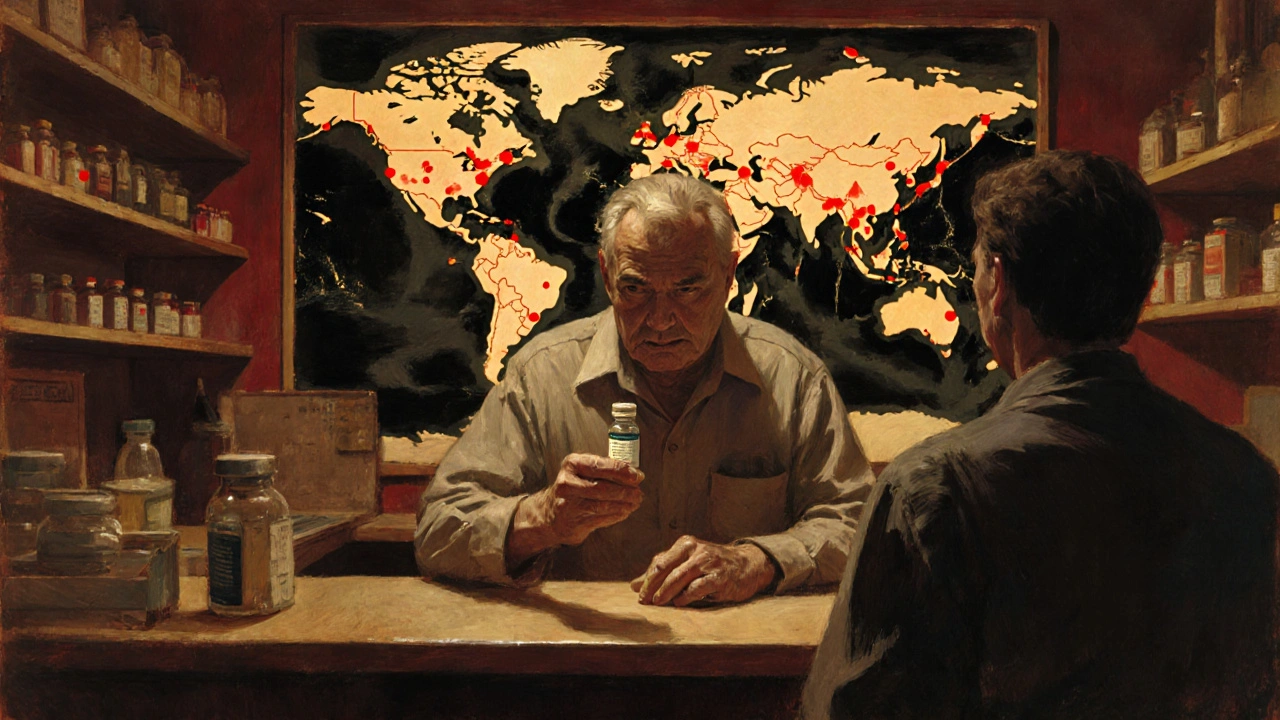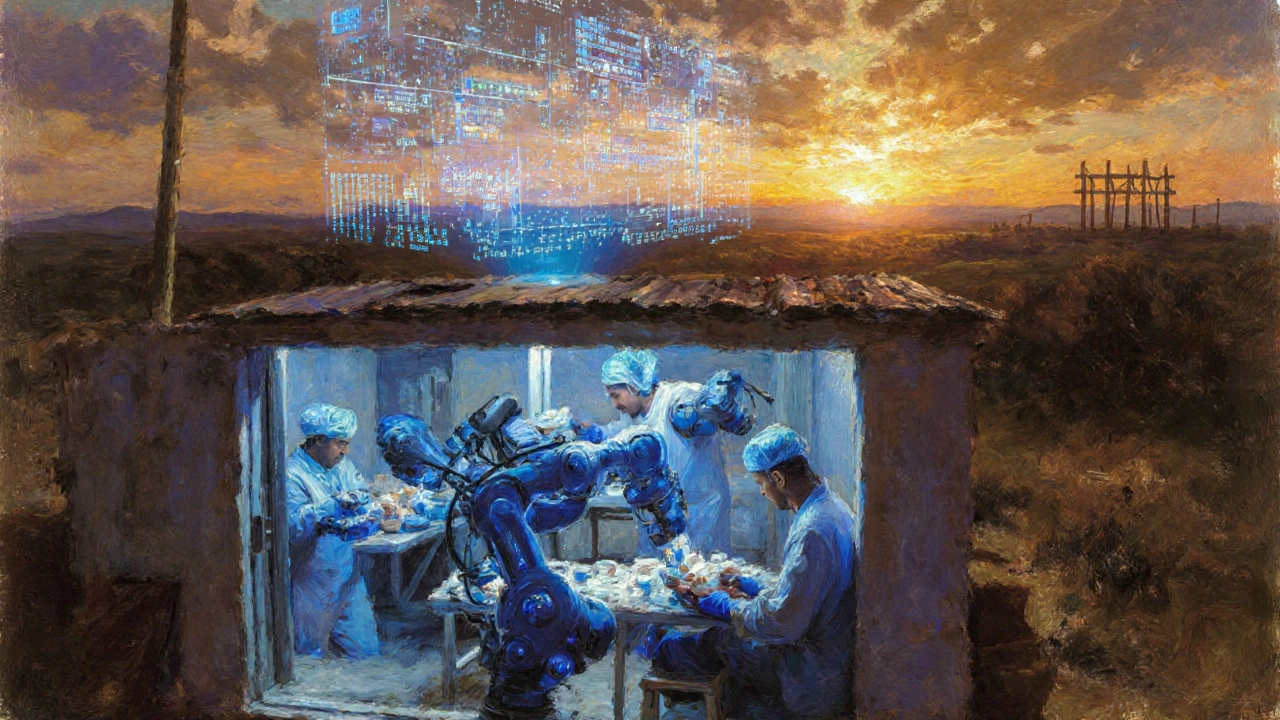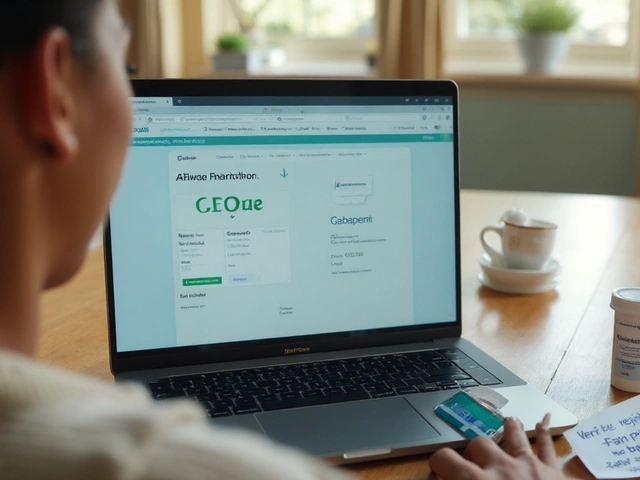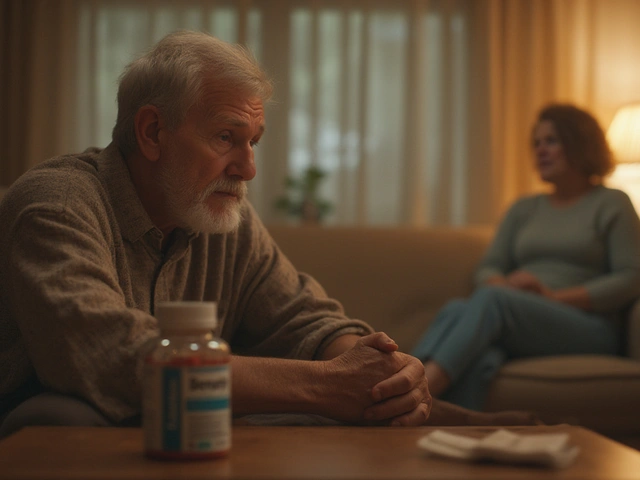By 2025, drug shortages aren’t just random glitches in the system-they’re predictable outcomes of a global manufacturing model that prioritized cost over control. If you’ve waited weeks for a generic antibiotic, struggled to refill a blood pressure medication, or watched your doctor scramble for alternatives, you’re not alone. You’re seeing the real-world impact of supply chains stretched thin across continents, with raw ingredients and active pharmaceutical ingredients (APIs) coming from just a handful of factories, mostly in China and India. This isn’t about politics. It’s about physics: when you break the link between production and demand, medicine doesn’t magically appear when you need it.
How Did We Get Here?
Thirty years ago, most medicines sold in the U.S. and Europe were made domestically. Today, over 80% of active pharmaceutical ingredients come from abroad, with China supplying nearly 40% of the world’s APIs and India handling 20% more-mostly for generics. The shift wasn’t sudden. It was a slow, calculated move to cut costs. A vial of metformin, for example, costs 70% less to produce in China than in the U.S. That’s money saved on paper. But behind that savings is a fragile chain: one port strike, one factory fire, one export ban, and hospitals run out.
The World Bank says Asia produces half of all global manufacturing output. For drugs, that number is even higher. In 2024, when China shut down several chemical plants for environmental inspections, the U.S. saw a 60% drop in the supply of certain antibiotics within weeks. No one had backup. No one had stockpiled. The system was built on “just-in-time,” not “just-in-case.”
Why Just-in-Time Doesn’t Work for Medicine
Think of your fridge. You don’t keep 100 loaves of bread because you might need one next Tuesday. You buy what you need for the week. That’s efficient. But what if bread was your only source of calories? You’d keep extra. Medicine is like that. You can’t wait 45 days for a new shipment of insulin if your patient’s blood sugar is crashing. Yet that’s exactly what happens when APIs are shipped from Shanghai to New Jersey.
Lead times have jumped 50% since 2019. A container that used to take 18 days to cross the Pacific now takes 27. Add customs delays, port congestion, and random regulatory checks-and you’re looking at 60 days minimum. Meanwhile, U.S. hospitals operate on 14-day inventory buffers. When supply slows, demand doesn’t. The gap widens fast.
McKinsey found that companies using “just-in-case” inventory models increased stock levels by 15% since 2022. But most small and mid-sized pharma companies didn’t. They couldn’t afford it. The big players did. That’s why you see shortages in generic drugs, not brand-name ones. Generics are low-margin, high-volume. No one wants to tie up cash in stock they might not sell for months.
The Domino Effect of Tariffs and Trade Wars
In 2024, the U.S. slapped 12 new tariff categories on $340 billion in imports-including critical chemical intermediates used to make antibiotics, antivirals, and heart medications. The goal was to protect domestic industry. The result? A 200-300% spike in the cost of some APIs. Many manufacturers didn’t raise prices. They just stopped making the drugs.
Companies that relied on single-source suppliers in China saw their margins collapse. Some went out of business. Others shifted production-but not fast enough. IDC reports that 78% of firms now use supplier diversification, up from 35% in 2020. But diversification isn’t plug-and-play. Setting up a second supplier in Vietnam or Mexico takes 18-24 months. It requires re-qualifying every batch, retraining staff, and re-certifying facilities with the FDA. That’s not something you do overnight.
And it’s not just tariffs. India, which used to be a reliable backup, started restricting exports of key APIs in 2023 to protect its own domestic market. That’s not unusual. Countries do it during crises. But when two major suppliers shut off the tap at the same time, the world feels it.

Nearshoring Is the New Lifeline
Some companies are waking up. One Fortune 500 medical device maker moved production of injectable antibiotics from China to Mexico in 2023. Result? Lead times dropped from 58 days to 22. On-time delivery jumped to 99.2%. Transportation costs fell 35%. Labor costs went up-by 15%-but the trade-off was worth it.
Nearshoring to Mexico and Eastern Europe isn’t a magic fix. It costs more. But it’s more reliable. The same company now keeps 45 days of inventory on hand instead of 14. That’s not waste. That’s insurance. And it’s working.
Microfactories-small, automated plants that can churn out a few thousand doses a day-are also gaining traction. They’re expensive to set up (40% more than traditional factories), but they respond to demand spikes in weeks, not months. One U.K.-based startup now produces generic thyroid medication in Bristol using AI-driven robotics. They can switch formulas in under 72 hours. That’s something a giant plant in Shanghai can’t do.
Who’s Getting Left Behind?
It’s not just hospitals. It’s patients. The National Foreign Trade Council found that 56% of healthcare providers have delayed new drug rollouts or cut back on offerings because they couldn’t guarantee supply. That means fewer treatment options. Fewer alternatives. More suffering.
Small pharmacies feel it worst. They can’t afford to buy in bulk. They can’t negotiate with suppliers like big chains can. When a drug runs out, they don’t have a second source lined up. They just tell the patient to come back next week. Sometimes, that week never comes.
And it’s not just about pills. It’s about syringes, IV bags, filters, and packaging. All of it comes from the same fragile network. A shortage of sterile vials in India? That stops production of vaccines in Germany. A labor strike in Malaysia? That halts production of inhalers used by asthma patients in Canada.

The Tech Fix That’s Actually Working
It’s not enough to move factories. You need to see the chain. That’s where digital twins and AI are changing the game. Digital twins-virtual replicas of supply chains-let companies simulate disruptions before they happen. One U.S. drugmaker used AI to predict a shortage of a common anticoagulant six months in advance. They rerouted production, switched suppliers, and avoided a crisis.
Blockchain is helping too. Instead of trusting paper certificates from overseas labs, companies can now verify API quality in real time. One manufacturer reduced quality disputes by 65% after switching to blockchain-based documentation. That means faster approvals, fewer delays, less waste.
But here’s the catch: 73% of U.S. manufacturers say they lack the talent to run these systems. Training workers in AI forecasting, digital logistics, and cybersecurity is now as critical as building new factories.
The Real Cost of Cheap Medicine
Professor Richard Baldwin of IMD Business School says reshoring is economically unfeasible because U.S. labor costs are 4.8 times higher than China’s. He’s right-if you only look at the price tag on the bottle.
But what’s the cost of a patient dying because their blood thinner ran out? What’s the cost of an ER visit because a diabetic couldn’t get insulin? What’s the cost of a hospital canceling elective surgeries because they couldn’t get antibiotics for post-op care?
The OECD estimates global GDP growth dropped to 2.9% in 2025 partly because of trade disruptions. But the real cost is measured in lives. And it’s rising.
What’s Next?
There’s no single solution. But there are clear paths forward:
- Build strategic stockpiles for critical drugs-not just for pandemics, but for routine shortages.
- Incentivize nearshoring with tax breaks and fast-track FDA approvals for qualified suppliers.
- Require transparency: companies must disclose where APIs are made and how many suppliers they use.
- Invest in automation and digital infrastructure. AI isn’t optional anymore-it’s survival.
- Train a new generation of supply chain specialists who understand both medicine and logistics.
The old model-cheap, fast, global-is broken. The new one won’t be perfect. But it will be more reliable. And in medicine, reliability isn’t a luxury. It’s the only thing that matters.
Why are drug shortages getting worse even though supply chains are improving?
Supply chains are getting more resilient overall, but that doesn’t mean medicine is safer. Most improvements focus on high-value goods like electronics or cars. Pharmaceuticals are low-margin, so they’re last in line for investment. Even with fewer global disruptions, the lack of backup suppliers and stockpiles means one problem still causes a nationwide shortage.
Can the U.S. make its own drugs again?
Yes, but not all of them-and not cheaply. The U.S. can produce most finished pills and injectables domestically. But the chemical building blocks (APIs) require specialized factories that cost hundreds of millions to build. It’s possible, but it takes time, money, and government support. Some companies are already doing it, like Pfizer’s new API plant in North Carolina, but scaling up will take a decade.
Are generic drugs more vulnerable than brand-name drugs?
Absolutely. Brand-name drugs often have one manufacturer with a monopoly, so they invest in multiple suppliers and stockpiles. Generics have dozens of makers competing on price. They cut corners on inventory and rely on the cheapest supplier-which is usually overseas. That’s why 80% of drug shortages involve generics.
How long does it take to switch a drug supplier?
At least 18 months. The FDA requires full testing of every batch from a new supplier. That includes stability tests, purity checks, and clinical validation. Even if the new factory is in Mexico and uses the same formula, regulators won’t approve it without months of paperwork and inspections. That’s why companies can’t just flip a switch during a crisis.
What can patients do if their medication is unavailable?
Talk to your doctor immediately. Many shortages have therapeutic alternatives-even if they’re more expensive or less convenient. Some pharmacies can source from international wholesalers (though legality varies). You can also check the FDA’s Drug Shortages page for updates and approved substitutions. Don’t stop taking your medication without medical advice.





